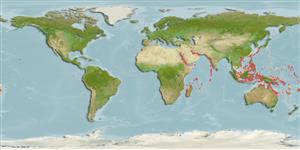Aquilonastra burtoni (Gray, 1840)
| Native range | All suitable habitat | Point map | Year 2050 |

|
| This map was computer-generated and has not yet been reviewed. |
| Aquilonastra burtoni AquaMaps Data sources: GBIF OBIS |
Upload your photos
Google image |
No photo available for this species.No drawings available for Asterinidae.
Google image |
No photo available for this species.
Classification / Names Common names | Synonyms | CoL | ITIS | WoRMS
| Valvatida | Asterinidae
Environment: milieu / climate zone / depth range / distribution range Ekologi
; djupintervall 0 - 10 m (Ref. 107862). Subtropical
Utbredning Länder | FAO områden | Ekosystem | Förekomster | Utplanteringar
Indo-Pacific and the Mediterranean.
Length at first maturity / Size / Vikt / Age
Maturity: Lm ? range ? - ? cm
Common in the lower eulittoral zone under rock slabs and boulders (Ref. 102838). Members of the family Asterinidae are very opportunistic feeders, feeding indiscriminately on small epifaunal organisms, detritus, decaying animals and plants, and live algae (Ref. 108108). Deposit feeder (Ref. 90951). Found in waters less than 30m. Associated with coral communities. Hides under rocks during the day. Feeds on bacterial film (Ref. 129602).
Life cycle and mating behavior Könsmognad | Reproduktion | Lek | Ägg | Fecundity | Larver
Members of the class Asteroidea exhibit both asexual (regeneration and clonal) and sexual (gonochoric) means of reproduction. Life cycle: Embryos hatch into planktonic larvae and later metamorphose into pentamorous juveniles which develop into young sea stars with stubby arms.
Main reference
referenser | Koordinator | Medarbetare
Koukouras, A. and M.-S. Kitsos. 2010. (Ref. 85345)
IUCN Red List Status (Ref. 130435)
CITES status (Ref. 108899)
Not Evaluated
CMS (Ref. 116361)
Not Evaluated
Threat to humans
Harmless
Human uses
| FishSource |
Verktyg
Ytterligare information
Age/Size
Tillväxt
Length-weight
Length-length
Morfologi
Larver
Abundans
Tillväxt
Length-weight
Length-length
Morfologi
Larver
Abundans
Internet-källor
BHL | BOLD Systems | CISTI | DiscoverLife | FAO(Publication : search) | Fishipedia | GenBank (genome, nucleotide) | GloBI | Gomexsi | Google Books | Google Scholar | Google | PubMed | Tree of Life | Wikipedia (Go, sök) | Zoological Record
Estimates based on models
Preferred temperature
(Ref. 115969): 25 - 29.2, mean 28.2 (based on 1740 cells).


